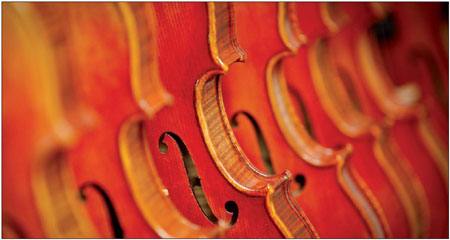Making Music
Updated: 2011-02-11 11:05
By Eric Jou and Hu Haiyan (China Daily European Weekly)
Chinese violin makers are catching up with the maestros and being heard worldwide
For Wang Zhiming, the violin has always been more than just a musical instrument. "My grandfather was an instrument tuner and maker, and my father was an instrument maker as well. I grew up playing the violin and running around instrument factories,?the 51-year-old Wang says.
Wang is now the owner of the Beijing-based Lu Mi Strings music company, which makes high-end, made-to-order Chinese violins.
Wang's factory, which currently employs 18 people and manufactures about 2,400 violins a year, is just one of Beijing's many violin makers in a country that supplies more than 70 percent of the world's violins.
|
|
China is the world's leading producer of musical instruments, including stringed, electric and traditional instruments. The country exports about 630,000 violins a year, of which nearly one-third are produced in Beijing, according to the Chinese Musical Instrument Association (CMIA).
The two biggest stringed instrument makers in China are Taixing Taile Violin Manufacturing Co, located in Jiangsu province's Xiqiao town, and Huadong Musical Instrument Co, located in Beijing's Donggao village, says Fu Yuankai, vice-secretary of the CMIA.
"Over the years, there has been more business and exchanges between China and Europe in regards to instrument sales," Fu says.
"Through the exchanges, Chinese manufacturers have gotten better and know their foreign customers better.
"Most of the Chinese instruments are still being made for export."
Chinese-made violins vary in quality and price, but are often entry-level violins. According to Fu, because Chinese instruments are still considered mass production items, they are perceived to be suffering from quality issues despite improvements.
"Chinese violins and violin makers are winning awards worldwide," Wang says. "But we still haven't gotten out of the game of making our products as outsourced work."
According to the CMIA, exports of the Chinese musical instrument industry account for nearly 764 million euros in the first three quarters of 2010, with exports to Europe flattening due to the global economic crisis.
Zhou Qian, owner of the Beijing-based Artwood musical instrument company, has been making violins for more than 30 years. She says that one of the problems with domestic violins is not so much the quality anymore, but the branding.
"I believe that the current instruments on the market are improving in quality, while most instruments are made for exports that are set to bear foreign brands," says Zhou, 50. "There are high-quality goods that sell in their own brands."
Zhou's violins themselves are so well received that one of her Italian outsourcing customers decided that they were no longer going to add their Italian brand to Zhou's Chinese violins. Instead, they designed a brand just for her Chinese violins.
Zhou's violins, like Wang's, are exported mainly to Italy and Germany, through professional players, schools and professors. According to Zhou, Chinese-made violins have attracted the attention of Italians.
"We export to Italy, and Italy as you know, is a place that is very picky about their violins," Zhou says. "One of my customers in Italy felt that the quality of my violins deserved a brand of their own, so instead of selling my violins as his own branded violins he said that he want to spread my brand."
Apart from branding and the prestige of European violins, Chinese violins are fundamentally different. Regardless of the crafting procedures, what makes Chinese violins cheaper and different from European violins is the wood. Chinese violins use wood from areas such as the Xinjiang Uygur autonomous region as well as Yunnan and Sichuan provinces.
A typical Chinese violin can sell for 99 pounds (115 euros) to 200 pounds, compared to an Italian one of similar quality that can go for 500 pounds to 1,000 pounds, Fu says.
Chinese violin makers also have the tendency to imitate famous and classical instruments, and often recreate them to order for customers. Zhou and Wang both say that their most popular models have been high-end imitations of Antonio Stradivari's most famous works.
"China has only been making violins for about 70 years, so there is an obvious gap there. You can't compare modern violins to old violins," Wang says.
"Because the domestic violins are still young compared to foreign violins and brands, Chinese violins suffer a lack of prestige despite being of good quality and often are only recreations or copies of prestigious violins."
Still, foreign instrument retailers are very keen on the idea of Chinese-made instruments. Citing cheap prices and quality, foreign retailers such as Foote's of London say that Chinese-made violins are great for beginners.
Chris Wing, Strings manager at Foote's of London, says there is a vast range in pricing but the quality of Chinese violins speaks for itself.
"They sell very well, there's a big range in terms of quality," Wing says.
"We sell a lot of the entry-level qualities because of the price, and we get some very good instruments right across the board.
"The quality of the stuff coming out of China these days is really good."
While retailers are interested and happy with Chinese violins, Italian violin makers are not worried. To Italian violin makers such as Eric Bolt, Chinese violins are just "good".
"The violins are very good," Bolt says. "I am not worried, because Italian violins are the best; there is history within what we do."
But many Chinese violin makers are also passionate about what they do.
Zhang Ning from Hebei province has worked for Wang at the Lu Mi Stringed Instrument company since she was 22. She now finds immense pleasure in her work.
"I've been making violins for the last 15 years. When I started I came to Beijing just for the sake of working at a violin factory. I wasn't interested in the violin at all," Zhang says.
"I was only interested in the benefits that came from the job, but now I understand the instrument. The wood and the instrument come alive as you carve it and then paint it.
"Coming from the countryside, this kind of work is great."
E-paper

Pearl paradise
Dreams of a 'crazy' man turned out to be a real pearler for city
Literary beacon
Venice of china
Up to the mark
Specials

Power of profit
Western companies can learn from management practices of firms in emerging economies

Foreign-friendly skies
About a year ago, 48-year-old Roy Weinberg gave up his job with US Airways, moved to Shanghai and became a captain for China's Spring Airlines.

Plows, tough guys and real men
在这个时代,怎样才"够男人"? On the character "Man"

